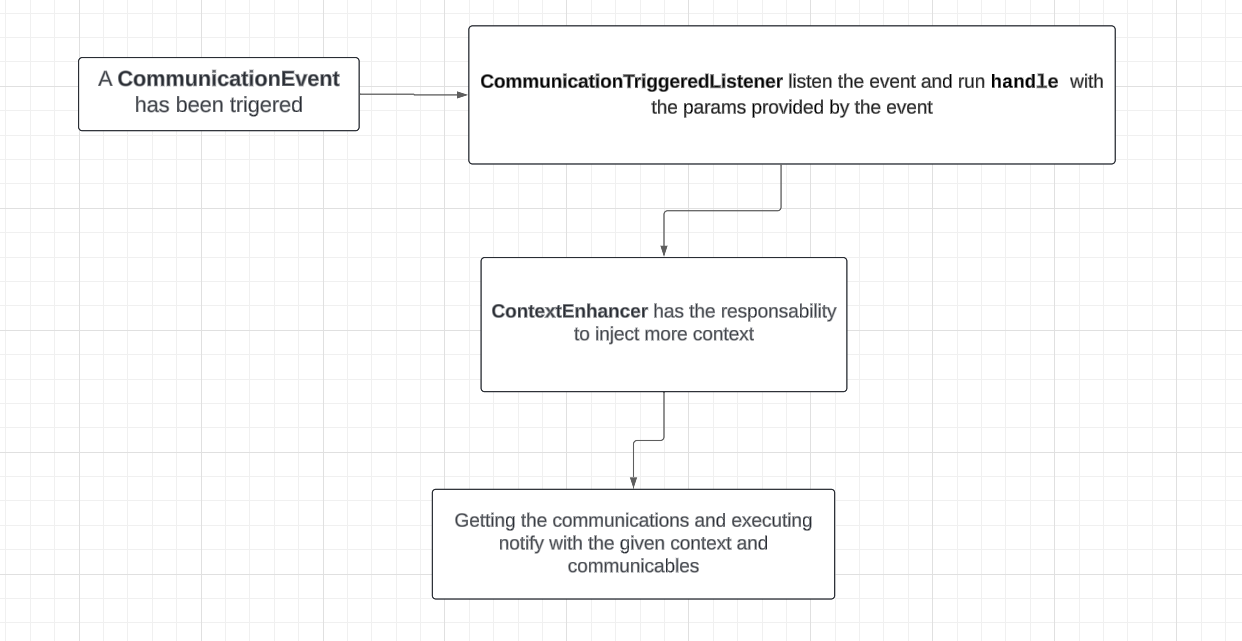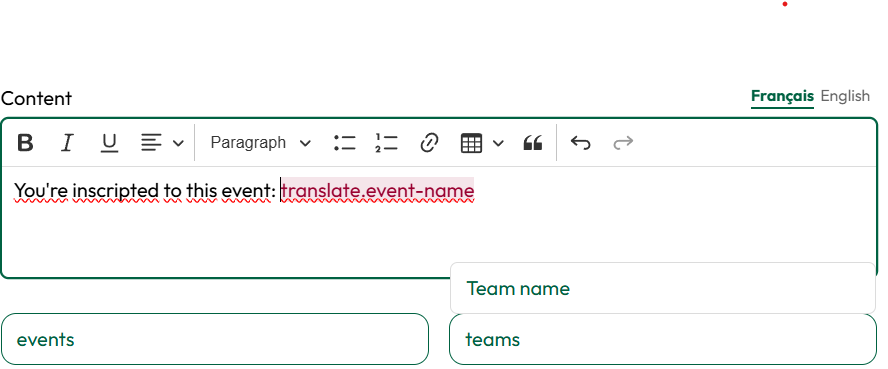condoedge / communications
A communications package for kompo/kompo
Installs: 1 285
Dependents: 1
Suggesters: 0
Security: 0
Stars: 0
Watchers: 0
Forks: 0
Open Issues: 0
pkg:composer/condoedge/communications
Requires
- php: ^8.0
- condoedge/tasks: ^0.2.11
- condoedge/utils: ^v0.2.12
- kompo/auth: >=0.4.88
- kompo/kompo: ^3.0
- laravel/framework: >=5.6.0
- laravel/vonage-notification-channel: ^3.3
This package is auto-updated.
Last update: 2025-12-02 02:51:48 UTC
README
Concept of Working
This package provides a way to handle communications within your application. It allows you to set up triggers, manage variables, and enhance context for events. The main idea is to have a way to send communications to users based on events that happen in the application. For example, you could send an email to a user when they register, or when they buy a product.
It provides a route /communication-templates where you can edit/create the templates for the communications with variables and types of communications.
Steps to Use It
Installation
To install the package, run the following command:
composer require condoedge/communications
Publishing configuration
To publish the configuration file, use the following command:
php artisan vendor:publish --tag="condoedge-communications-config"
Publishing javascript (Needed for the CKeditor)
To publish the JavaScript files required for CKEditor, use the following command:
php artisan vendor:publish --tag="condoedge-communications-js"
Setting communicables
Each kind of communications has their own interface to be implemented by the communicable model. For example, the EmailCommunicable model implements the EmailCommunicable interface. So if the communication is an email, the communicable model should implement the EmailCommunicable interface or it'll be ignored.
Our actual interfaces are:
EmailCommunicableSMSCommunicableDatabaseCommunicable(Notifications)
Setting Up Triggers
To set up a trigger, you need to create an event that will trigger the communication. Below is an example of how to create a trigger event:
<?php class RandomTriggerer implements CommunicableEvent { use Dispatchable, InteractsWithSockets, SerializesModels; protected $event; protected $teamsIds; public function __construct($event) { $this->event = $event; } function getParams(): array { return [ 'event' => $this->event, ]; } // If you don't set communicables, the communication won't be sent function getCommunicables(): array|Collection { return CommunicableRandom::where('event_id', $this->event->id)->get(); } static function getName(): string { return __('communications.a-random-triggerer'); } }
Next, set the communication triggers in the kompo-communications config file:
<?php return [ 'triggers' => [ OpenedReinscriptions::class, ], ];
Introducing CKEditor
To implement CKEditor, use the _EnhancedEditor helper in your kompo component. In communications, it is used in the EmailCommunicationHandler to allow the user to write the email content with variables.
Using Variables in CKEditor
To see variables in the editor, set the variables as follows:
// AppServiceProvider.php Variables::setVariables([ 'events' => [ // ID, name, classes, automatic handling (access to the object and attribute) ['event.name_ev', 'Event name', 'bg-level1', true] ], 'teams' => [ ['team_name', 'Team name', 'bg-level1', false] ] ]);
Replacing Content with Variables
The content will replace the variables in the text with the provided values. You can also use the automatic handling of the variables ({model.attribute}) for simple cases.
// AppServiceProvider.php ContentReplacer::setHandlers([ 'team_name' => function ($team) { return $team->name; } ]);
Enhancing Context for Events
You can enhance the context that you'll provide in the events. You can also implement the enhanceContext method in the model to do this, which is often a better approach.
ContextEnhancer::setEnhancers([ 'event' => function ($event) { return [ 'team' => $event->team, 'teams_ids' => [$event->team_id], ]; } ]);
or
// RandomModel.php public function enhanceContext() { return [ 'team' => $this->team, 'teams_ids' => [$this->team_id], ]; }
Setting default communications for triggers
To set the default communications for each trigger, you can use the provided button on the list page. You need to configure the default communications for each trigger in the resources\views\stubs\communication-templates directory. The file structure should follow this format:
default-{slugged-name-of-the-trigger}-{number-of-type-of-communications}-{locale-key}.blade.php
For example: default-opened-reinscriptions-1-en.blade.php
The name of the trigger is given by $trigger::class.
Here's a breakdown of the numbering system for each type of communication:
- Email: 1
- SMS: 2
- Notification: 3
Make sure to update the appropriate file for each trigger and communication type.
Sending communications ways
We use the Laravel Mail facade to send emails.
You should change the file communication-layout.blade.php to your email layout.
SMS
We use the vonage API to send SMS.
Database
We use the Laravel Notification system to send notifications with some enhancements to manage them. Giving the possibility to provide some custom notifications handlers.
Extending sending ways
We don't have an easy way to do this. We'll need a refactor for do CommunicationType enum setteable from a config file. Now it's static.
We have an specific handler for each type of communications. Implementing a different way to send communications, and save them.
You should create a new handler and extends the AbstractCommunicationHandler class.
class EmailCommunicationHandler extends AbstractCommunicationHandler { public function communicableInterface() { return EmailCommunicable::class; } // NOTIFICATION /** * @param EmailCommunicable[] $communicables * @param mixed $params * @return void */ public function notifyCommunicables(array $communicables, $params = []) { $layout = $params['layout'] ?? DefaultLayoutEmailCommunicable::class; $communicables = collect($communicables)->map(function($communicable) use ($layout, $params) { $params = ContextEnhancer::setCommunicable($communicable)->getEnhancedContext($params); Mail::to($communicable->getEmail())->send(new $layout($this->communication, $params)); }); } }


